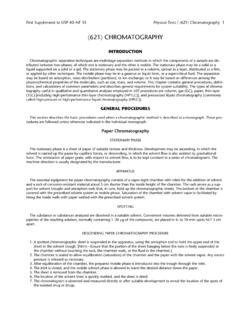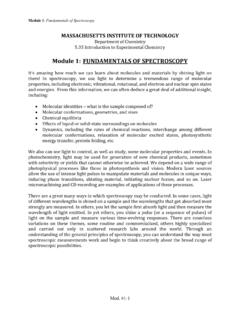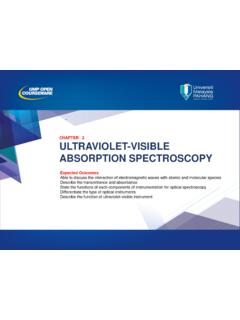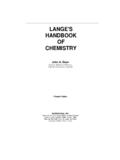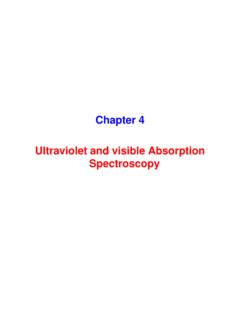Transcription of INTRODUCTION A Tl 857 ULTRAVIOLET-VISIBLE …
1 USP 40 Physical Tests / 857 ULTRAVIOLET-VISIBLE spectroscopy 1. 857 ULTRAVIOLET-VISIBLE spectroscopy . INTRODUCTION . ULTRAVIOLET-VISIBLE (UV-Vis) spectra are derived when the interaction between incident radiation and the electron cloud in a chromophore results in an electronic transition involving the promotion of one or more of the outer shell or the bonding elec- trons from a ground state into a state of higher energy. The UV and visible spectral bands of substances generally are broad and do not possess a high degree of specificity for compound identification. Nevertheless, they are suitable for quantitative assays and, for many substances, are useful as an additional means of identification.
2 In the Beer Lambert law the absorbance (Al) of a solution at given wavelength, l, is defined as the logarithm to base 10 of the reciprocal of the transmittance (Tl): Il = intensity of the transmitted radiation at the same wavelength l Il0 = intensity of the incident radiation at wavelength l In the absence of any other physical or chemical factors, Al is proportional to path length, b, through which the radiation passes, and to the concentration, c, of the substance in the solution in accordance with the following: Al = elcb el = molar absorptivity c = solute concentration (mol/L). b = path length (cm).
3 If the concentration, c, is expressed in g/L, the constant el becomes al, which is called the absorptivity. The expression which represents the specific absorbance of a dissolved substance, refers to the absorbance of a 10-g/L solution (1% m/v) in a 1-cm cell measured at a defined wavelength so that: M = molar concentration of the solution When solutions are observed in 1-cm cells, concentrations of about 10 mg of the specimen per mL often will produce absor- bances of in the UV or visible region. For discussion of the theory and principles of measurements, see ULTRAVIOLET-VISIBLE spectroscopy Theory and Practice 1857 , a general information chapter that is not a mandatory resource.
4 QUALIFICATION OF UV-VIS SPECTROPHOTOMETERS. The suitability of a specific instrument for a given procedure is ensured by a stepwise life cycle evaluation for the desired application from selection to instrument retirement: design qualification (DQ); installation qualification (IQ); an initial perform- ance-to-specification qualification, also known as operational qualification (OQ); and an ongoing performance qualification (PQ). For more details, see Analytical Instrument Qualification 1058 . The purpose of this chapter is to provide test methodologies and acceptance criteria to ensure that the instrument is suitable for its intended use (OQ), and that it will continue to function properly over extended time periods as part of PQ.
5 As with any spectrometric device, a UV-Vis spectrophotometer must be qualified for both wavelength (x-axis) and photometric (y-axis, or signal axis) accuracy and precision, and the fundamental parameters of stray light and resolution must be established. OQ is carried out across the operational ranges required within the laboratory for both the absorbance and wavelength scales. Installation Qualification The IQ requirements provide evidence that the hardware and software are properly installed in the desired location. Operational Qualification Acceptance criteria for critical instrument parameters that establish fitness for purpose are verified during IQ and OQ.
6 Specifications for particular instruments and applications can vary depending on the analytical procedure used and the desired 2 857 ULTRAVIOLET-VISIBLE spectroscopy / Physical Tests USP 40. accuracy of the final result. Instrument vendors often have samples and test parameters available as part of the IQ/OQ pack- age. Wherever possible in the procedures detailed as follows, certified reference materials (CRMs) are to be used in preference to laboratory-prepared solutions. These CRMs should be obtained from a recognized accredited source and include independent- ly verified traceable value assignments with associated calculated uncertainty.
7 CRMs must be kept clean and free from dust. Recertification should be performed periodically to maintain the validity of the certification. Control of Wavelengths Ensure that the accuracy of the wavelength axis (x-axis) over the intended operational range is correct within acceptable limits. For non-diode array instruments, wavelength accuracy and precision are determined over the operational range using at least six replicate measurements. For wavelength accuracy, the difference of the mean measured value to the certified value of the CRM must be within 1 nm in the UV region (200 400 nm), and in the visible region (400 700 nm) must be within 2.
8 Nm. For wavelength precision, the standard deviation of the mean must not exceed nm. For diode array instruments, only one wavelength accuracy measurement is required, and no precision determination needs to be performed. The difference be- tween the certified and measured value of the CRM must not exceed 1 nm in the UV region (200 400 nm), and in the visible region (400 700 nm) must not exceed 2 nm. ATOMIC LINE SPECTRA. This procedure is described as the primary application because the emission lines produced from a discharge lamp are char- acteristic of the source element and, as a fundamental physical standard, these wavelengths have been measured with an un- certainty of NMT nm.
9 In solution spectrometry, the wavelength accuracy required rarely exceeds nm. For these rea- sons, the atomic line standard values are cited without uncertainty. The lamp needs to be placed at the source position in the spectrophotometer; thus, it can be used only in spectrophotometers that can be operated in a single-beam intensity mode and practically should be implemented only on a system designed to accommodate these sources, , as an accessory. A commonly employed low-pressure mercury lamp has a number of intense lines that cover a large part of the UV and visi- ble spectra. Two deuterium lines from the source at and nm often are used by manufacturers as an internal cali- bration check and can be used for diagnostic purposes (Table 1).
10 1. Table 1. Recommended Atomic Lines from Low-Pressure Mercury and Deuterium Lamps for Wavelength Calibration Purposes Element nm Hg Hg Hg Hg Hg D2 Hg Hg Hg D2 RARE EARTH OXIDE SOLUTIONS. This procedure uses solutions of rare earth oxides prepared by dissolution in acid media. The most frequently used is holmi- um oxide in perchloric acid. Holmium oxide solution has been internationally accepted as an intrinsic wavelength standard, and suitable CRMs are available The observed peak maxima are determined using the normal scan mode on the spectrophotometer. The peak maxima for a 4% m/v solution of holmium oxide in perchloric acid at spectral band- width and a path length of 1 cm are shown in Table 1 The rounded values are taken from ASTM Standard E275-08.
